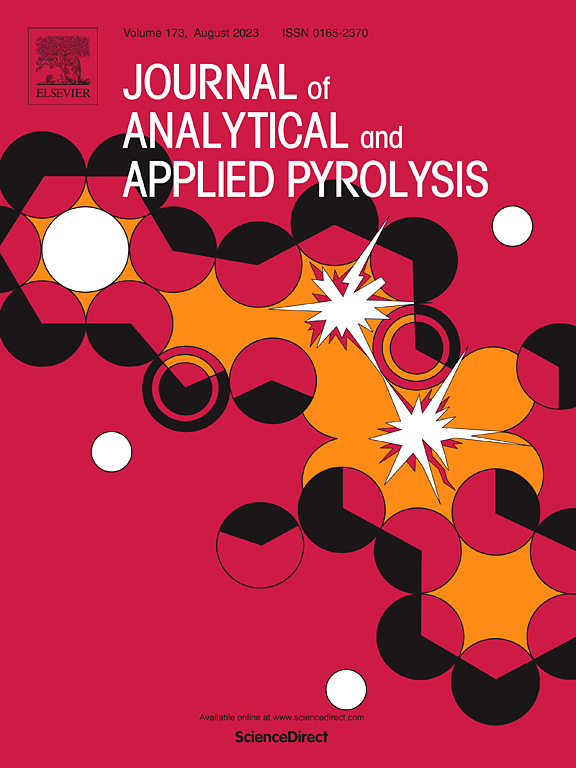Exploring the effects of calcium bicarbonate on endogenous phosphorus conversion and pyrolysis product distributions of oil crop residues
IF 6.2
2区 化学
Q1 CHEMISTRY, ANALYTICAL
引用次数: 0
Abstract
Phosphorus-rich oil crop residues hold significant potential for use as phosphate fertilizers. Pyrolysis can enhance the enrichment of phosphorus in bio-char, although the transformation process remains unclear. To improve the availability of phosphorus and optimize its forms in bio-char, calcium bicarbonate (Ca(HCO₃)₂) was introduced in this study to analyze its effects on the transformation of phosphorus forms and the distribution of pyrolysis products. The addition of Ca(HCO₃)₂ increased the carbon monoxide (CO) content in the pyrolysis gas. Meanwhile, Ca(HCO₃)₂ reduced the acidity of bio-oil while increasing the aliphatic hydrocarbons content. The introduction of Ca(HCO₃)₂ promoted the formation of calcium-phosphorus (Ca-P) compounds. When the addition of Ca(HCO₃)₂ was at 10 %, the content of hydrochloric acid-soluble phosphorus (HCl-P) reached its maximum at 74.3 %, which was advantageous for phosphorus utilization. However, excessive amounts of Ca(HCO₃)₂ can lead to the conversion of HCl-P into residual phosphorus (RP), making it essential to maintain an appropriate proportion. Increasing the pyrolysis temperatures enhanced the lower heating value (LHV) of the gas due to the increased concentration of combustible gases, such as hydrogen (H2), methane (CH4), and carbon monoxide (CO). Additionally, the levels of aromatic and aliphatic hydrocarbons in bio-oil increased with rising temperatures, which is significant for subsequent high-value applications. Furthermore, elevated temperatures promoted an increase in the total phosphorus content in bio-char. However, lower temperatures (≤500 ℃) facilitated the reaction between Ca(HCO₃)₂ and organic phosphates, leading to the formation of HCl-P. In contrast, higher temperatures (≥600 ℃) resulted in the conversion of HCl-P to RP.
探讨碳酸氢钙对油料作物秸秆内源磷转化及热解产物分布的影响
富磷油料作物残茬具有作为磷肥使用的巨大潜力。热解可以增强生物炭中磷的富集,但其转化过程尚不清楚。为了提高生物炭中磷的利用率,优化其形态,本研究引入碳酸氢钙(Ca(HCO₃)2),分析其对热解产物磷形态转化和分布的影响。Ca(HCO₃)2的加入增加了热解气体中一氧化碳(CO)的含量。Ca(HCO₃)2降低了生物油的酸度,同时增加了脂肪烃的含量。Ca(HCO₃)2的引入促进了钙磷(Ca- p)化合物的形成。当Ca(HCO₃)2的添加量为10 %时,盐酸可溶性磷(HCl-P)的含量达到最大值,为74.3 %,有利于磷的利用。但是,过量的Ca(HCO₃)2会导致HCl-P转化为残余磷(RP),因此必须保持适当的比例。随着热解温度的升高,由于氢气(H2)、甲烷(CH4)和一氧化碳(CO)等可燃气体浓度的增加,气体的较低热值(LHV)增强。此外,随着温度的升高,生物油中芳香烃和脂肪烃的含量也会增加,这对后续的高价值应用具有重要意义。此外,温度升高促进了生物炭中总磷含量的增加。然而,较低的温度(≤500℃)有利于Ca(HCO₃)2与有机磷酸盐的反应,导致HCl-P的生成。温度越高(≥600℃),HCl-P越容易转化为RP。
本文章由计算机程序翻译,如有差异,请以英文原文为准。
求助全文
约1分钟内获得全文
求助全文
来源期刊
CiteScore
9.10
自引率
11.70%
发文量
340
审稿时长
44 days
期刊介绍:
The Journal of Analytical and Applied Pyrolysis (JAAP) is devoted to the publication of papers dealing with innovative applications of pyrolysis processes, the characterization of products related to pyrolysis reactions, and investigations of reaction mechanism. To be considered by JAAP, a manuscript should present significant progress in these topics. The novelty must be satisfactorily argued in the cover letter. A manuscript with a cover letter to the editor not addressing the novelty is likely to be rejected without review.

 求助内容:
求助内容: 应助结果提醒方式:
应助结果提醒方式:


